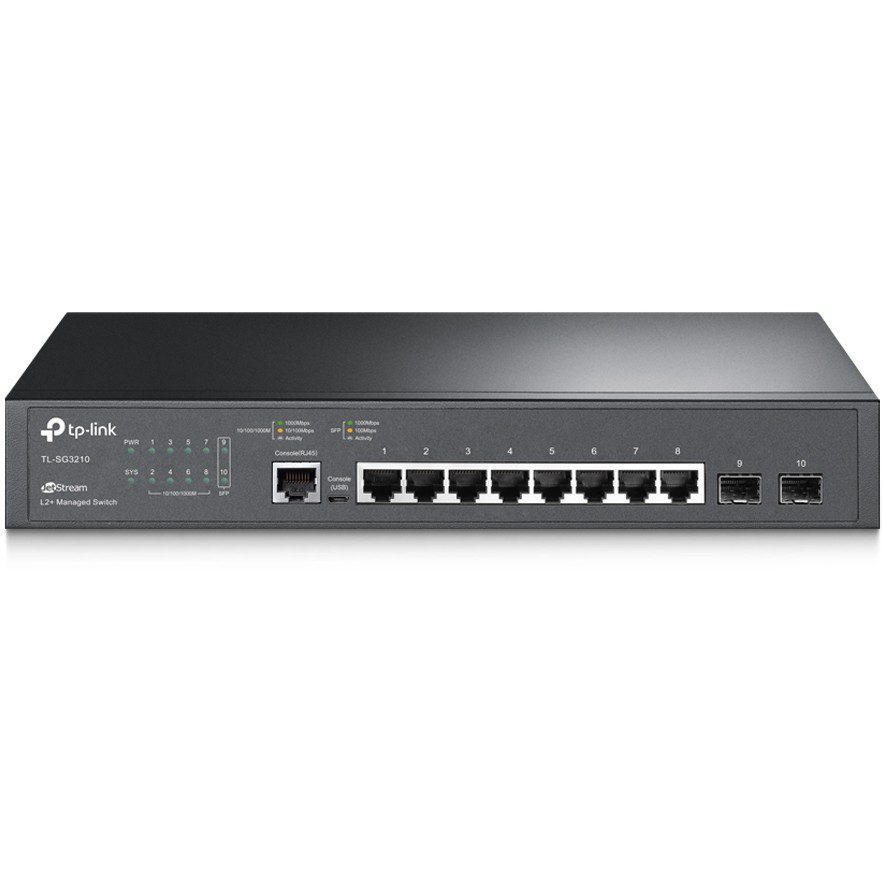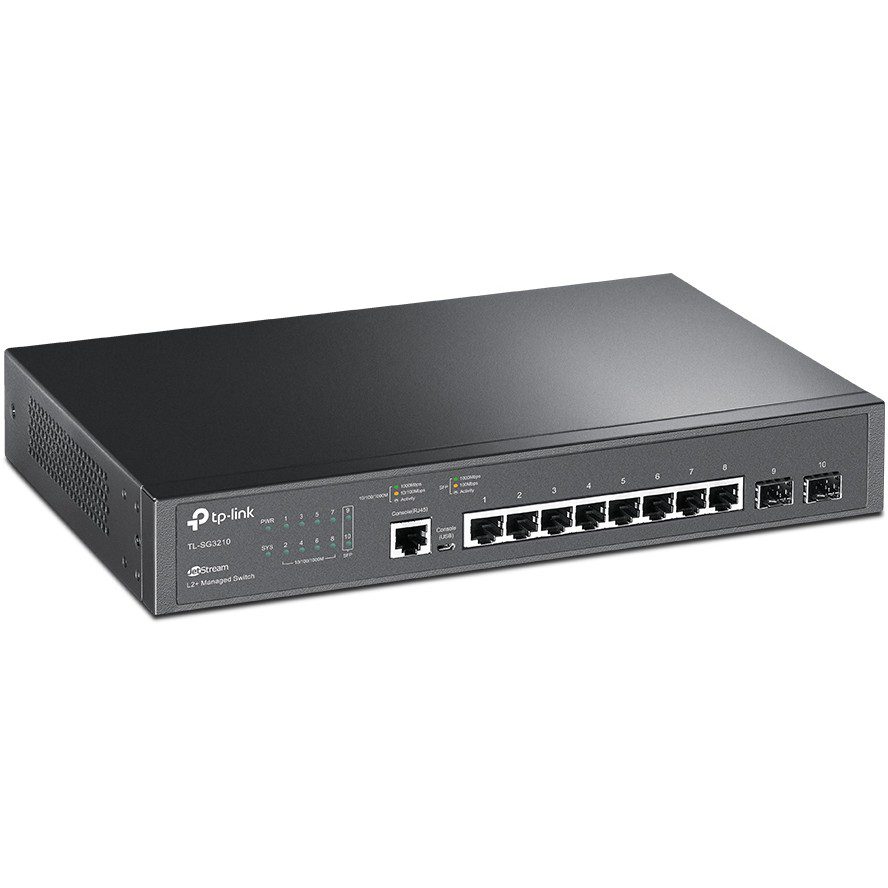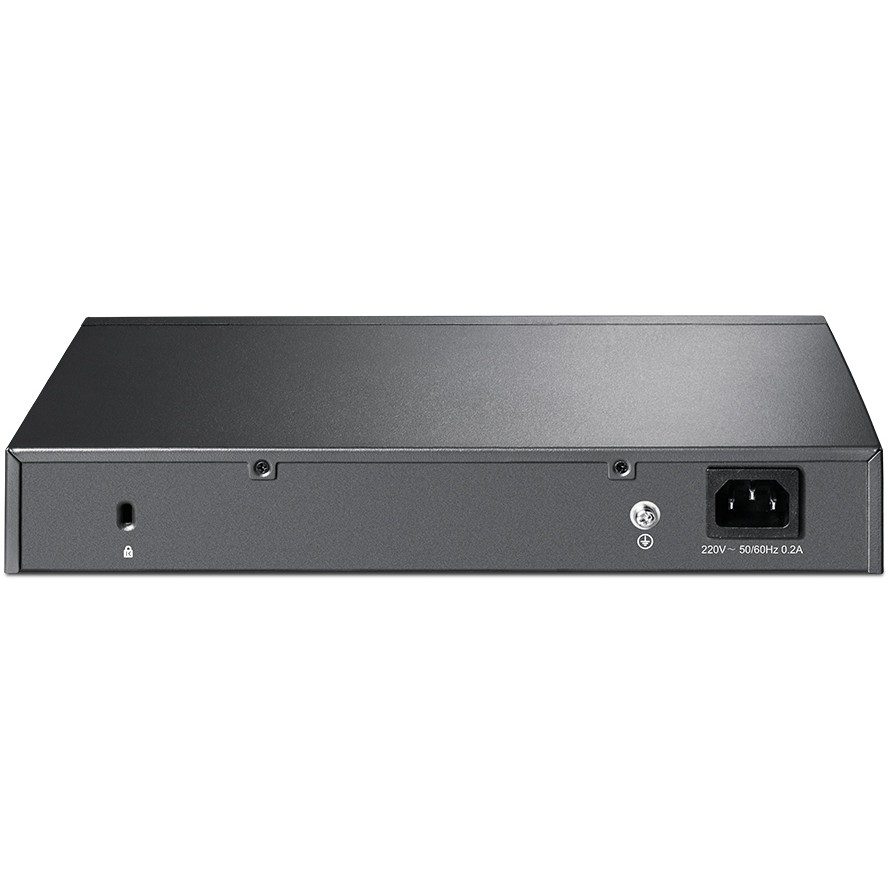8+2P TP-Link Omada SG3210 M
€150.83
TP-Link JetStream 8-port Gigabit L2+ managed switch with 2 SFP slots, managed, L2/L3, Gigabit Ethernet (10/100/1000), rack mount, 1U
3 in stock
Description
TP-Link JetStream 8-port Gigabit L2+ managed switch with 2 SFP slots. Switch type: Managed, Switch level: L2/L3. Basic switching RJ-45 Ethernet ports type: Gigabit Ethernet (10/100/1000), Number of basic switching RJ-45 Ethernet ports: 8, Console port: RJ-45/micro-USB. MAC address table: 8000 entries, Routing/switching capacity: 20 Gbit/s. Network standard: IEEE 802.1D, IEEE 802.1Q, IEEE 802.1p, IEEE 802.1s, IEEE 802.1w, IEEE 802.1x, IEEE 802.3ab, IEEE…. Rack installation, form factor: 1U
Practical L2+ managed gigabit switch integrated in the Omada Omada SDN
JetStream 8-Port Gigabit L2 + Managed Switch with 2 SFP Slots
Reliable gigabit connections
8 × Gigabit RJ45 ports and
2 × Gigabit SFP ports
Central cloud management
SDN integration for an efficient network
Advanced L2+ features
L2 / L3 / L4 QoS, ACL, static routing and more
Comprehensive security strategies
Investment protection in the LAN area
Software Defined Networking (SDN) with cloud access
The Omada Software Defined Networking (SDN) platform integrates network devices, including access points, switches and gateways, and provides 100% centralized cloud management. Omada creates a highly scalable network controlled through a single interface, centrally controlling seamless wireless and wired connections and is ideal for use in areas such as hospitality, education, retail, offices and more.
Effortless cloud or on-premises controller
Multi-Site Cloud Management
Zero-Touch Provisioning (ZTP)
Intelligent monitoring
Advanced L3 features
A variety of L2+ and L3 features are supported to help build a highly scalable and robust network that provides a reliable and efficient solution for enterprises, sites and ISPs.
Secure network
Security features include IP-MAC-Port-VID binding, port security, storm control, and DHCP snooping to defend against a range of network threats. A built-in list of common DoS attacks is available, making them easier than ever to prevent. In addition, the Access Control Lists (ACL, L2 to L4) feature restricts access to sensitive network resources by denying packets based on source and destination MAC address, IP address, TCP/UDP ports, or VLAN ID. Users' network access can be controlled via 802.1X authentication, which works with a RADIUS/Tacacs+ server to grant access only when valid user credentials are provided.
Enterprise-level features
A full range of L2+ features are supported, including 802.1Q VLAN, port mirroring, STP/RSTP/MSTP, Link Aggregation Control Protocol, and 802.3x flow control. Advanced IGMP snooping ensures that the switch intelligently forwards multicast streams only to the appropriate participants, avoiding unnecessary traffic, while IGMP throttling and filtering restricts each participant at the port level to prevent unauthorized multicast access. Static routing is a simple method of segmenting the network and forwarding traffic internally through the switch to improve efficiency.
Advanced QoS
Voice and video traffic can be prioritized based on IP address, MAC address, TCP port number, UDP port number, and more. With QoS (Quality of Service), voice and video services remain smooth even when bandwidth is tight.
ISP Features
sFlow, QinQ, L2PT PPPoE ID insertion and IGMP authentication features are specifically designed for ISPs. 802.3ah OAM and DLDP (Device Link Detection Protocol) provide easy monitoring and troubleshooting of network connections.
IPv6 support
IPv6 features such as dual IPv4/IPv6 stack, MLD snooping, IPv6 ACL, DHCPv6 snooping, IPv6 interface, Path Maximum Transmission Unit (PMTU) discovery and IPv6 Neighbor Discover ensure that your network is ready for the Next Generation Network (NGN) without upgrading your hardware.



